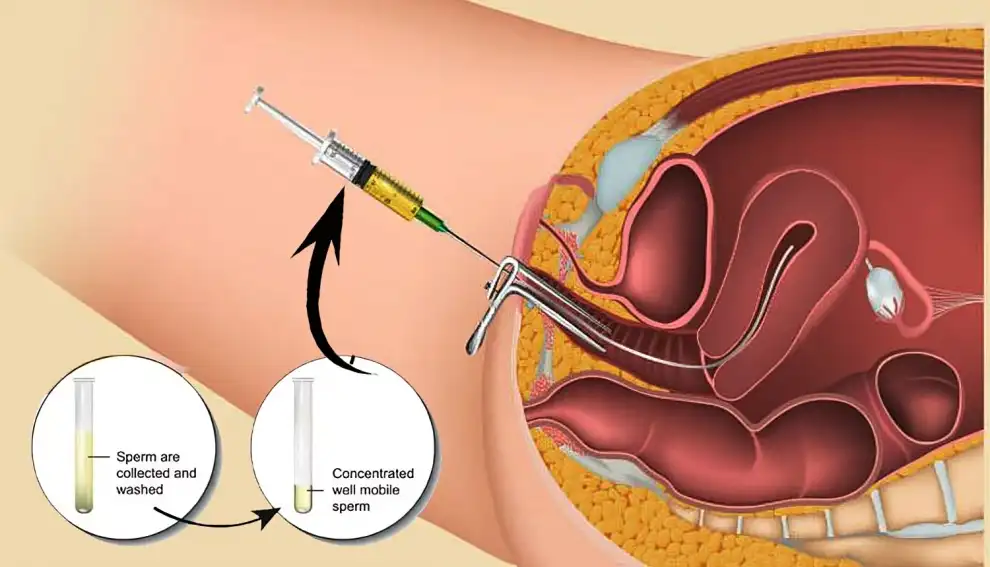- Introduction
- What is Intrauterine Insemination (IUI)?
- The Procedure of Intrauterine Insemination (IUI)
- Risks Associated with IUI
- 7 Benefits of Intrauterine Insemination (IUI) for Fertility Treatment
- 1. Increased Sperm Count: Enhancing Fertilization Odds
- 2. Timing Optimization: Precision Matters
- 3. Cervical Mucus Compatibility: Navigating Obstacles
- 4. Treatment for Unexplained Infertility: Unlocking Possibilities
- 5. Minimal Side Effects: Gentle on the Body
- 6. Cost-Effective: Making Dreams Affordable
- 7. Emotional Support: Nurturing Hope
- Success Rate of IUI
- Conclusion
- FAQ
Introduction
Intrauterine Insemination (IUI): In the journey toward parenthood, couples facing fertility challenges often explore various assisted reproductive technologies. One such option gaining popularity is Intrauterine Insemination (IUI). This minimally invasive procedure offers hope to couples struggling to conceive naturally. Let’s delve into the world of IUI, understanding its effectiveness and why it’s becoming a go-to choice for hopeful parents.
The Rising Popularity of IUI
As fertility awareness grows, so does the interest in IUI. Couples are increasingly turning to this method due to its simplicity, affordability, and promising results. Unlike more complex procedures like in vitro fertilization (IVF), IUI offers a less invasive path to pregnancy. It involves placing specially prepared sperm directly into the uterus, bypassing potential obstacles and increasing the chances of fertilization.
What is Intrauterine Insemination (IUI)?
Understanding the Basics
Intrauterine Insemination (IUI), also known as artificial insemination, is a fertility treatment designed to enhance the chances of conception. Here’s how it works:
- Sperm Preparation: Before the procedure, the male partner provides a semen sample. The sample undergoes processing in the laboratory, where sperm are separated from other components. This preparation ensures that only healthy, motile sperm are used. Intrauterine Insemination (IUI)
- Targeted Placement: During IUI, a thin catheter is inserted through the cervix and into the uterus. The prepared sperm are then gently deposited directly into the uterine cavity. By placing the sperm closer to the egg, IUI optimizes the chances of successful fertilization. Intrauterine Insemination (IUI)
When Is IUI Recommended?
IUI is often recommended for couples facing specific fertility challenges:
- Mild Male Factor Infertility: If the male partner has a low sperm count, reduced motility, or minor abnormalities, IUI can be an effective solution. By bypassing potential barriers (such as cervical mucus), IUI increases the chances of sperm reaching the egg.
- Unexplained Infertility: In cases where no clear cause of infertility is identified, IUI serves as a logical step. It provides a controlled environment for sperm and egg interaction, potentially overcoming unexplained barriers.
- Cervical Factor Infertility: Some women have cervical conditions (such as mucus abnormalities or cervical stenosis) that hinder sperm passage. IUI bypasses the cervix, allowing sperm to reach the uterine cavity directly.
- Ovulation Disorders: Women with irregular ovulation cycles or anovulation (lack of ovulation) can benefit from IUI. The procedure is often timed with ovulation induction medications to maximize the chances of conception.
The Promise of IUI
While IUI may not be suitable for all fertility issues, its simplicity, cost-effectiveness, and minimal invasiveness make it an attractive option. Couples appreciate the convenience of IUI, as it can be performed in a clinic setting without the need for anesthesia or extensive recovery time.
Intrauterine Insemination (IUI) offers hope to couples navigating the complexities of fertility challenges. As technology advances and awareness grows, IUI continues to play a vital role in helping couples achieve their dream of parenthood. If you’re considering fertility treatments, consult a reproductive specialist to explore whether IUI is the right path for you. 🌟
The Procedure of Intrauterine Insemination (IUI)
Intrauterine Insemination (IUI) is a fertility treatment that offers hope to couples trying to conceive. Here’s a breakdown of the procedure:
- Ovarian Stimulation:
- Before IUI, the woman may undergo ovarian stimulation. Fertility medications (such as Clomid or letrozole) encourage the growth of multiple follicles (fluid-filled sacs containing eggs) in the ovaries.
- Regular monitoring through ultrasound and blood tests ensures optimal follicle development.
- Sperm Preparation:
- The male partner provides a semen sample, which is processed in the laboratory.
- Sperm are separated from seminal fluid and other components. The goal is to obtain a concentrated sample of healthy, motile sperm. Intrauterine Insemination (IUI)
- Insemination:
- On the day of IUI, the woman lies on an examination table, similar to a pelvic exam.
- A thin, flexible catheter is inserted through the cervix and into the uterine cavity.
- The prepared sperm are loaded into the catheter and gently released into the uterus.
- The entire process takes only a few minutes and is usually painless.
The Non-Invasive Nature of IUI
IUI stands out for its non-invasive approach. Unlike more complex procedures like in vitro fertilization (IVF), IUI doesn’t require surgery or anesthesia. It’s performed in an outpatient setting, allowing couples to resume their daily activities immediately afterward. The absence of major discomfort or recovery time makes IUI an attractive choice for many couples seeking fertility assistance. Intrauterine Insemination (IUI)
Risks Associated with IUI
While IUI is generally safe, it’s essential to be aware of potential risks:
- Infection:
- Any procedure involving the cervix and uterus carries a slight risk of infection.
- Strict sterile techniques during sperm preparation and catheter insertion minimize this risk.
- Discomfort or Cramping:
- Some women may experience mild discomfort or cramping during or after IUI.
- This discomfort is usually brief and manageable. Intrauterine Insemination (IUI)
- Multiple Pregnancy:
- IUI increases the chances of multiple pregnancies (twins, triplets, etc.).
- Close monitoring during ovarian stimulation helps reduce this risk. Intrauterine Insemination (IUI)
- Ectopic Pregnancy:
- Although rare, there’s a small risk of the fertilized egg implanting outside the uterus (usually in the fallopian tube).
- Early detection and monitoring are crucial. Intrauterine Insemination (IUI)
Consult with a Healthcare Professional
To minimize risks, consult with a reproductive specialist before undergoing IUI. They will assess your specific situation, provide personalized guidance, and ensure a safe procedure. Remember that open communication and informed decision-making lead to the best outcomes. If you’re considering IUI, take that important step toward building your family with confidence. 🌟
7 Benefits of Intrauterine Insemination (IUI) for Fertility Treatment
1. Increased Sperm Count: Enhancing Fertilization Odds
Intrauterine Insemination (IUI) offers a strategic advantage for couples dealing with male factor infertility. When the male partner has a low sperm count, IUI becomes a game-changer. Here’s how it works:
- Sperm Concentration: During IUI, the laboratory prepares a concentrated sample of healthy sperm. By bypassing the cervix and placing the sperm directly into the uterus, IUI ensures that a higher number of sperm are available to meet the waiting egg. Intrauterine Insemination (IUI)
- Overcoming Low Count: Even if the initial sperm count is low, IUI maximizes the chances of successful fertilization. It’s like sending a focused team of swimmers directly to the finish line.
2. Timing Optimization: Precision Matters
Timing is critical in the quest for conception. IUI allows precise timing of insemination:
- Ovulation Window: IUI is timed to coincide with the woman’s ovulation. The sperm are introduced into the uterus when the egg is ready for fertilization. Intrauterine Insemination (IUI)
- Increased Odds: By hitting the bullseye during the fertile window, IUI significantly increases the likelihood of sperm meeting egg. This precision minimizes missed opportunities.
3. Cervical Mucus Compatibility: Navigating Obstacles
The cervix plays gatekeeper, and its mucus can either facilitate or hinder sperm movement. IUI takes the scenic route:
- Bypassing the Cervix: IUI neatly sidesteps any cervical mucus issues. The sperm travel directly into the uterine cavity, avoiding potential roadblocks. Intrauterine Insemination (IUI)
- Smooth Sailing: Whether the mucus is thick, hostile, or unpredictable, IUI ensures that sperm encounter minimal resistance. It’s like having a VIP pass through the cervical checkpoint.
4. Treatment for Unexplained Infertility: Unlocking Possibilities
Unexplained infertility can be frustrating. IUI steps in as a detective:
- Exploring Options: When standard tests reveal no clear cause, IUI becomes a viable treatment option. It provides a controlled environment for sperm and egg interaction.
- Boosting Odds: By introducing prepared sperm directly into the uterus, IUI increases the chances of conception. Sometimes, the unexplained becomes the achievable.
5. Minimal Side Effects: Gentle on the Body
Compared to more invasive fertility treatments like in vitro fertilization (IVF), IUI is a gentle player:
- Non-Invasive: IUI doesn’t involve surgery or anesthesia. It’s an outpatient procedure performed in a clinic setting.
- Minimal Discomfort: Most women experience minimal discomfort—akin to a routine pelvic exam. Recovery time is negligible.
6. Cost-Effective: Making Dreams Affordable
Finances matter, especially when navigating fertility treatments. IUI offers a budget-friendly path:
- Affordable: IUI is significantly more cost-effective than IVF. It’s accessible to a broader range of couples.
- Multiple Attempts: Couples can opt for multiple IUI cycles without breaking the bank. It’s like investing wisely in hope.
7. Emotional Support: Nurturing Hope
Infertility can take an emotional toll. IUI provides more than physical benefits:
- Hope and Encouragement: The process itself becomes a beacon of hope. Couples find solace in taking proactive steps toward their dream of parenthood. Intrauterine Insemination (IUI)
- Shared Journey: IUI involves both partners, fostering emotional connection and mutual support. It’s a collective voyage towards a mutual objective.
Intrauterine Insemination (IUI) isn’t just about sperm meeting egg—it’s about hope, precision, and affordability. If you’re on the path to parenthood, consider IUI as a promising ally. 🌟

Success Rate of IUI
Intrauterine Insemination (IUI) is a commonly utilized method that provides hope to couples facing challenges with conception. But what are the chances of success? Let’s dive into the statistics and explore the factors that influence IUI outcomes.
Understanding Success Rates
- Overall Success: The success rate of IUI varies based on several factors, including age, underlying fertility issues, and the number of cycles attempted. On average, the success rate per cycle ranges from 10% to 20%. However, this is a general estimate, and individual experiences can differ significantly. Intrauterine Insemination (IUI)
- Age Matters: Age plays a crucial role. Typically, younger females often achieve greater success rates. For women under 35, the success rate per cycle may be closer to 15% to 20%. As age increases, the chances decline. Women over 40 may experience success rates as low as 5% to 10% per cycle.
- Fertility Issues: The cause of infertility matters. IUI is more effective for certain conditions:
- Mild Male Factor: When the male partner has minor sperm abnormalities, IUI can significantly improve the odds.
- Unexplained Infertility: IUI serves as a valuable option when no clear cause is identified.
- Cervical Factor: If cervical mucus issues hinder sperm movement, IUI bypasses the cervix.
- Cumulative Success: Many couples undergo multiple IUI cycles. The cumulative success rate (considering several cycles) is higher than the per-cycle rate. Some couples achieve pregnancy after two or three cycles, while others may need more attempts. Intrauterine Insemination (IUI)
Conclusion
- Patience and Persistence: IUI requires patience. Success may not happen immediately, but persistence pays off. Multiple cycles increase the chances of achieving pregnancy. Intrauterine Insemination (IUI)
- Emotional Support: The emotional journey matters. IUI can be both hopeful and challenging. Turn to your partner, friends, or support communities for emotional assistance.
- Consult with a Specialist: Every couple’s situation is unique. Consult with a fertility specialist to assess your specific case. They’ll consider your age, medical history, and any underlying conditions. Together, you can make informed decisions.
Remember, success rates are just one piece of the puzzle. The journey toward parenthood is multifaceted, and IUI is a valuable tool in that journey. If you’re considering fertility treatments, take that step with hope and determination. 🌟
FAQ
- What are the benefits of IUI fertility treatment?
- Increased Sperm Count: IUI concentrates healthy sperm directly into the uterus, overcoming low sperm count issues.
- Timing Optimization: Precise timing during the fertile window enhances the chances of fertilization.
- Cervical Mucus Compatibility: IUI bypasses cervical mucus obstacles.
- Treatment for Unexplained Infertility: Couples with unexplained infertility benefit from IUI.
- Minimal Side Effects: IUI is less invasive than other treatments.
- Cost-Effective: IUI is more affordable than in vitro fertilization (IVF).
- Emotional Support: The process provides hope and support.
- Who Benefits from IUI?:
- Couples facing mild male factor infertility, unexplained infertility, or cervical issues.
- Women below 35 typically exhibit elevated rates of success.
- What are the advantages of insemination?
- Precision: IUI allows precise timing during ovulation.
- Gentle Procedure: Minimal discomfort, no surgery, and quick recovery.
- Cost-Effective: A budget-friendly fertility option.
- Is IUI 100% Successful?:
- No, IUI success rates vary. It’s essential to consider individual factors and multiple cycles.
- Is IUI Painful?:
- Most women experience minimal discomfort, similar to a pelvic exam.
- Is IUI Successful in the First Try?:
- While some achieve pregnancy after one cycle, multiple attempts may be needed.
- What Happens on Day 15 After IUI?:
- Around day 15, a pregnancy test can detect early signs of pregnancy.
- Can I Take a Bath After IUI?:
- Yes, you can resume normal activities, including bathing, after IUI.
- What Happens After 7 Days of IUI?:
- Around 7 days post-IUI, implantation may occur if successful. A pregnancy test can confirm.
*Image credits- freepik*
Important Notice:
The information provided on “health life ai” is intended for informational purposes only. While we have made efforts to ensure the accuracy and authenticity of the information presented, we cannot guarantee its absolute correctness or completeness. Before applying any of the strategies or tips, please consult a professional medical adviser.















